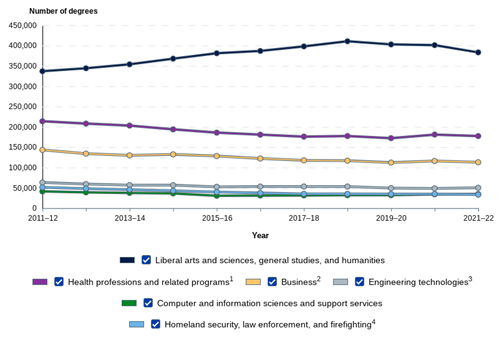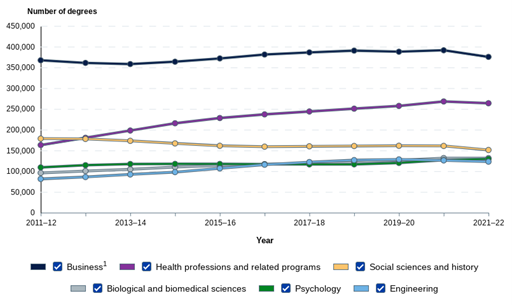85% of Aralia Students Place in Top Writing Competitions
The Most Popular Associate's Degree Majors

In the 2021–22 academic year, U.S. postsecondary institutions awarded 1 million associate’s degrees. Surprisingly, 79% of these degrees were in only six main fields:
Liberal Arts and Sciences, General Studies, and Humanities (38%)
Health Professions and Related Programs (18%)
Business (11%)
Engineering Technologies (5%)
Computer and Information Sciences and Support Services (3%)
Homeland Security, Law Enforcement, and Firefighting (3%)
Among six majors, Liberal Arts and Sciences, General Studies, and Humanities is the most popular degree, highlighting the education topics where students see the most value. Liberal Arts and Sciences, General Studies, and Humanities’ broad-based program covering social and physical sciences, languages, literature, art, music, philosophy, and psychology can provide students with general education that can be applied in many fields. Some potential career opportunities from the major can be human resource management or user experience (UX) design. Next in line is Health Professions and Related Programs, which remain a highly appealing career path for young professionals due to their strong job prospects, especially in response to the growing demand for healthcare workers. As the U.S. population ages, there is an increasing need for healthcare professionals. According to the Bureau of Labor Statistics (BLS), several healthcare roles, such as radiation therapists, dental hygienists, and Veterinary Technologists and Technicians, only require an associate degree for entry-level positions.
Top Bachelor's Degree Choices

At the bachelor’s level, 2 million degrees were awarded in 2021–22, with 58% concentrated in six main areas:
Business (19%)
Health Professions and Related Programs (13%)
Social Sciences and History (7%)
Biological and Biomedical Sciences (7%)
Psychology (6%)
Engineering (6%)
Business and Health Professions have been top choices for students across different racial and ethnic groups over the past decade, showing that these areas are in demand and offer strong job opportunities. Business degrees, in particular, have remained the most popular choice for the past ten years, thanks to the degree’s versatility, which opens doors to careers in areas such as marketing, operations, and supply chain management across different industries. Similarly, a bachelor’s degree in healthcare offers not only job security but also high-paying entry-level positions. According to the Bureau of Labor Statistics (BLS), roles like medical dosimetrists, registered nurses, and dietitians/nutritionists are among the highest-paid entry-level positions in the healthcare sector requiring a bachelor’s degree.
Associate Degree vs. Bachelor's Degree
Associate degree programs often emphasize practical skills geared toward immediate job opportunities or facilitating transfers to further education, generally a bachelor’s degree. As an associate degree is usually more cost-effective and requires less time commitment (typically 2 years), students usually target majors with higher career opportunities like specialized training in healthcare or technology fields. In contrast, bachelor’s degrees provide a more comprehensive educational experience, offering deeper academic exploration, broader career opportunities, and enhanced long-term professional prospects, although they come at a higher cost and with a four-year commitment. Bachelor’s degrees tend to unlock more advanced career paths, higher starting salaries, and greater potential for professional or academic advancement.
Despite these differences, three areas of study — Business, Health Professions and Related Programs, and Engineering/Engineering Technologies — consistently appear in the top six most popular majors for both degree levels, highlighting their strong job prospects and promising future opportunities. Ultimately, the choice between these educational paths depends on individual career goals, financial resources, personal learning preferences, and specific industry requirements.
Unlock Your Writing Potential: Students in Our Writing Competition Preparation Class Are More Likely to Secure Awards
Why This Information Matters
For parents of high school students, knowing which majors are popular can help guide your child toward fields with good future employment opportunities. Educators can use this information to advise students and develop programs that match what students are interested in and what the job market needs. Students can learn about which majors are in demand to help them choose a field they enjoy that also offers good career opportunities.
What To Do Next
Consider In-Demand Majors: Research popular majors like business or health professions to see what the current opportunities in the market are and are there growing potential in the future.
Stay Updated on Trends: As trends can change every year, staying updated with information about even the less popular fields like engineering technology and computer science can provide parents and students with more options to consider when it is time to decide on college majors.
Developing Strategies for College Applications: Choosing a popular college major can be both promising and highly competitive. By understanding current trends, parents and students can craft a more strategic college application to stand out. Developing competitive advantages, such as strong soft skills and , is an effective way to enhance a student’s application.
Use School Resources: Understanding trends can help with informing decisions but it is not everything. Talk to school counselors to see how these trends fit with students’ interests and strengths.
When selecting a college major, parents and students should look beyond just trends, recognizing that individual academic strengths, personal interests, and unique abilities are equally critical in making an informed decision. While data about trending majors provides valuable input, successful career paths are ultimately built on a foundation of personal passion, inherent skills, and alignment with one’s academic profile. Indeed, some less popular majors like education, mathematics, and agriculture demonstrate promising job market projections according to the Bureau of Labor Statistics, highlighting that high demand isn’t always correlated with major popularity. By carefully considering personal ability alongside market insights, students can discover rewarding career opportunities in fields that might be overlooked by the broader student population.
Understanding current U.S. education enrollment trends can provide valuable insights for students, parents, and educators in making informed decisions. Fields like Business and Health Professions dominate both associate’s and bachelor’s degree programs, reflecting their strong job prospects and versatility. Additionally, specialized degrees in areas such as Engineering Technologies and Computer and Information Sciences and Support Services are gaining traction for their immediate career applicability. These trends highlight the importance of aligning academic choices with evolving labor market demands. By staying informed, students can make strategic decisions that not only align with their interests but also offer promising career opportunities in the future.










